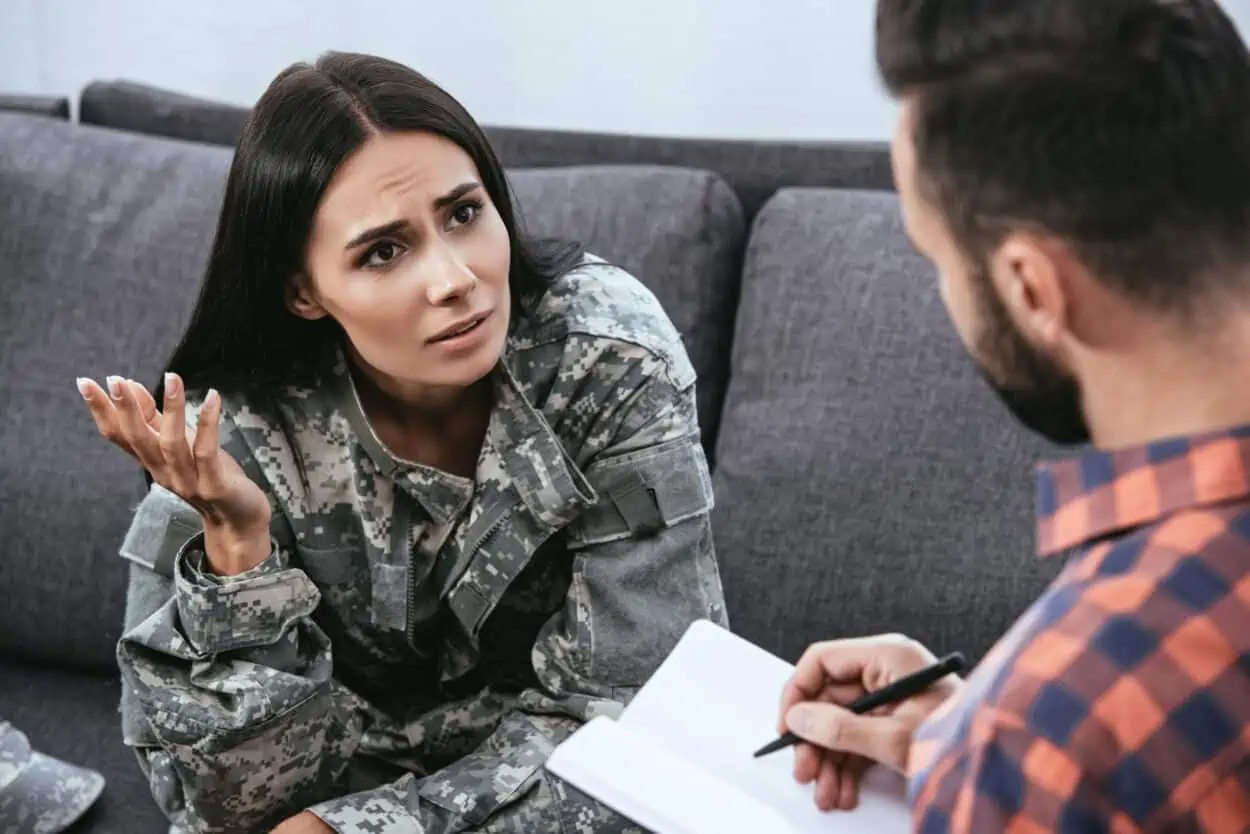
PTSD is a surprisingly common form of mental illness that can make it difficult to feel safe and to relax and trust others.1 Unsurprisingly, this can make relationships with someone who suffers from PTSD more difficult.
Despite this, people suffering from PTSD can and do have fantastic, loving, supportive relationships. If you’re considering dating someone with PTSD, I’m going to explain all the things you need to know and give you some important tips to help you build a healthy relationship.
Table of Contents
There can be a lot of misunderstanding around the exact symptoms of PTSD. This is partly because most people won’t have all of these symptoms and because they’re often very skilled at hiding or masking what’s going on for them.
Here are some of the realities of living with PTSD that you might need to know about if you’re thinking of dating someone with trauma.
The first thing to understand is that there are two main types of post-traumatic stress disorder; PTSD and cPTSD.2 PTSD is the ‘typical’ form of PTSD, where someone develops symptoms after experiencing a severe traumatic event.
Complex PTSD (cPTSD) is subtly different. This is the result of a sustained period of abuse or harm rather than a single traumatic event.3 This might apply to people who have been taken hostage for an extended period of time or who were subjected to child abuse, for example.
It’s important to note that not everyone who experiences a traumatic event will develop PTSD. Despite how your partner might feel, having PTSD doesn’t make them weak.
Hypervigilance is a common symptom of PTSD where someone is permanently on the alert for potential threats.4 Often, this is specific to the kind of trauma that they have experienced. For example, if they were raped, they might be especially vigilant for threatening behavior from men. If they were in a serious car accident, they might be hypervigilant for vehicles.
Put like this, hypervigilance sounds like a superpower. They can spot threats that other people might miss. Unfortunately, it rarely works that way.
They’re constantly on edge and scanning for threats, which is emotionally exhausting. They’re also so alert to potential threats that they get lots of “false positives.” This leaves them either overreacting to non-threats or having to ignore their internal warnings about potential threats.
If your partner has had PTSD for a long time, they might have developed strategies to deal with their hypervigilance, such as always sitting with their back to a wall. They might become agitated and anxious if they are stopped from doing this.

PTSD is a condition that never really goes away, but people who have been dealing with it for a long time will usually be able to distract themselves enough to cope during everyday life. Unfortunately, this often means that they suffer most at night when they are either alone or at least in private.
PTSD can make it difficult for sufferers to get to sleep.5 They might have intrusive thoughts or flashbacks whenever they close their eyes (more on this later). They might also become very light sleepers and wake up anxiously at every small noise.
PTSD can also give people vivid nightmares. Sometimes they are disoriented when they wake up, which can be distressing for them and anyone they’re sharing a bed with.
Most people are familiar with the idea that people with PTSD can experience flashbacks to their trauma, but you might not entirely realize what that is like.
One of the theories around how PTSD develops is that an event, experience, or series of experiences is so traumatic that your brain fails to accurately mark that experience as being in the past. That means that, when you think about it, you don’t experience it as a memory. You experience it as happening now.
That’s what a PTSD flashback feels like. It isn’t a mental image or like watching a movie. It usually includes your different senses, so you might smell the things you smelled at the time as well as see and hear the same things.
Someone with PTSD will usually find that their flashbacks are identical or at least very similar.6 They all go back to that huge traumatic event.
If they have cPTSD, it’s slightly different. They might experience different flashbacks. They might also experience flashbacks that are a combination of lots of different events or that slide from one event to another without stopping.
Flashbacks can also last for different lengths of time. For some people, it might be only a few seconds. Others might experience a series of flashbacks lasting for hours.
Someone with PTSD has experienced an extreme situation. In many cases, this will involve someone else deliberately doing harm to them or to someone they love. Some of their fears, anxieties, and beliefs about the world might seem irrational to you.7
It’s important to recognize that they might have a very different experience of the limits of human behavior to you. They may also draw parallels or links between things that seem very different to you.
For example, someone who was abused as a child by a parent who put huge amounts of salt in their food might become extremely anxious if other people have access to their food or if they don’t have a sealed snack in their pocket. They might not be able to eat in a restaurant because they need to see their food being prepared.
These kinds of fears can be hurtful to you as their partner because they feel like a lack of trust in you rather than a symptom of their PTSD.
Use this tool to check whether he actually is who he says he is
Whether you're married or have just started seeing someone, infidelity rates are on the rise and have increased over 40% in the last 20 years, so you have all the right to be worried.
Perhaps you want to know if he's texting other women behind your back? Or whether he has active Tinder or dating profile? Or worse yet, whether he has a criminal record or is cheating on you?
This tool will do just that and pull up any hidden social media and dating profiles, photos, criminal records, and much more to hopefully help put your doubts to rest.
Another symptom of PTSD that can make life difficult in a relationship is that they might become angry and frustrated easily.8 They might also struggle to control those feelings.
Different people will express their emotions differently. They might shout and throw things or just curl up into a ball and cry. They might also demand apologies and redress for small problems as a way of expressing their anger.
When you know that your partner’s anger is associated with their PTSD, it can put you in a difficult position. You know that they don’t mean it, but it’s important that you don’t allow yourself to be put into an unsafe situation. PTSD is not an excuse for abusing or harming others.

As well as having emotional outbursts, people suffering from PTSD can become emotionally blank or shut themselves off. They might refuse to speak, pull away from you, or simply walk away from a situation.
They can sometimes become so divorced from their feelings that they start dissociating.9 This is when they actually stop being able to feel anything at all and they start to feel distant from themselves and as if they can’t quite tell the difference between what’s real and what’s not.
People can dissociate to different degrees. They might simply feel as though their emotions are out of reach or they might completely “zone out” and find that they have no memory of what they’ve just been doing and they don’t know where they are.
When someone we love is struggling, we usually want to know more about what’s going on. We want to know what’s wrong. We want to know what they’re thinking and feeling in the hope that we’ll be able to help.
When you’re dating someone with PTSD, this might not be something that they can give you. If they’re dissociating, they might not know what they’re thinking or feeling, and they might not have the words to describe it if they did.
Even if they’re not dissociating, there are lots of reasons why it might not be safe for someone with PTSD to share the details of what happened to them. Talking about what happened can trigger flashbacks for some people. They might also have been rejected or shamed when they’ve talked about it in the past.
As their partner, you might need to learn to support and love them without knowing anything about what actually happened. Try to remind yourself that they only need to share their trauma if it helps them, not because you want to know.
If you’ve never encountered PTSD before, this sounds counterintuitive, or just plain crazy. If someone has been through hell, why would they try to go back there? Unfortunately, taking part in risky activities is really common for people with PTSD.10
This is partly because abuse and trauma are familiar to them. This is especially common for people with cPTSD. They might simply not understand how to be in a loving and healthy relationship and so go back to abusive exes or put themselves in dangerous situations.
This may also be part of why many people with PTSD abuse drugs and alcohol. They are trying to numb the pain but they’re also engaging in risk-taking behavior because, deep down, they don’t believe that they deserve to feel safe and loved.
Seeing someone you love put themselves at risk over and over is incredibly painful, and this can often be the final straw for partners of people with PTSD.
Someone with PTSD will typically have a good idea about what is likely to set off an acute PTSD attack. These things are known as triggers and can cause flashbacks, anger, dissociation, and any of the other symptoms we’ve listed so far.
Given how distressing this can be, most people with PTSD will go to considerable lengths to avoid their triggers.11 This is sometimes a good thing, but it can make your life difficult as their partner. They might need to stay away from certain smells or tastes, for example, which can limit the social events that you can attend together.
This can also make intimacy difficult, especially if their triggers are around touch or sexual activity. You may need to be especially vigilant to ensure that you don’t accidentally set off one of their triggers.
When we talk about PTSD triggers, it’s important to be clear that we’re using this word in the technical sense. Having your PTSD “triggered” doesn’t mean that you simply feel uncomfortable or sad.
Being “triggered” can lead some people with PTSD to lose awareness of where they currently are. They might re-experience the most traumatic moments of their lives. These are moments so traumatic that their brain hasn’t been able to fully process them.
They might also have intrusive thoughts, a racing heartbeat, or uncontrollable shaking and sobbing. The relationship between a trigger and the reaction is usually very fast and automatic.12
It’s unusual for someone with PTSD to have control over their reaction to being triggered until they’ve done significant work with a therapist to deal with that specific trigger.
Everyone with PTSD will have their own specific triggers, based on the exact trauma and experiences that led to their condition in the first place. For example, veterans might find themselves triggered by loud noises such as fireworks because they are too similar to the sounds of gunfire.
Some of the most common PTSD triggers that you might encounter in your relationship include physical intimacy, powerlessness, loud noises, specific smells, touch to a particular part of the body, certain voices or accents, or large crowds.

Although PTSD can be debilitating for some people, it is a chronic condition and most people who suffer from it will learn to deal with many of their problems and challenges. Here are some of the ways that you can help them and look after yourself at the same time.
When you’re dating someone with PTSD, it’s not uncommon for you to struggle with a form of secondary trauma or to find it difficult to accept and deal with what your partner has had to experience.
Make things easier on both of you by finding a great therapist early on. This helps you to create a stable foundation for offering support for your partner as well as making sure that you don’t burn out as a result of offering them your love and care.
Your partner might also be reassured that you’re seeing a therapist. People with PTSD can often worry about the impact that their condition has on the people who love them and this can exacerbate feelings of guilt and difficulties with their self-worth.
Knowing that you have support and you’re taking care of yourself can make it easier for them to open up to you.
When you’re dating someone with PTSD, it’s often helpful to encourage them to seek treatment and to support them in finding the right treatment for them. Often, people with PTSD can struggle to trust others and they might initially be offered treatment that is not right for them and their needs.
If their PTSD is due to a single traumatic event, a type of therapy known as EMDR (eye movement desensitization and reprogramming) can help them to process the memory in a more effective and non-traumatic way.13
One of the most common forms of therapy offered to people with PTSD is known as CBT (cognitive-behavioral therapy). Although this works for around half of people, it’s not effective for others. This is especially likely if your partner is suffering from cPTSD.14
Encourage your partner to try different forms of therapy until they find the one that is right for them. Reassure them that some forms of treatment will work better for them than others. Try not to get discouraged if their first attempts don’t produce the results you’re both hoping for.
One of the hardest things about dating someone with PTSD is that you might feel as though you ought to be able to make it better if you could just love them enough to undo the pain that they’ve been through. That’s understandable, but that kind of thinking is going to put a strain on your relationship.
Your love will never be able to heal them because their PTSD isn’t down to anything that you did. Trying to heal them also puts you at risk of falling into a codependent relationship.
It also makes your whole relationship about their trauma, which isn’t healthy for either of you. Remind yourself that they’re a complete person already. They have trauma and baggage, but they’re still a wonderful person who you fell in love with.
Triggers are really serious, and they’re not yours to try to work on. Sometimes, your partner might ask you to work on a trigger with them, but you should never take it upon yourself to try to desensitize them to something that is causing them a problem.
Remember that your partner might be hypervigilant, especially about their triggers. Try to ease some of the burdens on them by keeping an eye out for things that will cause them a problem and removing you both from the situation.
For example, if your partner is triggered by loud noises, don’t suggest going to a firework display. If you see someone else about to set off fireworks, suggest that you leave and go home.

So far, we’ve been talking about the challenges of PTSD. When you start dating someone with PTSD, you might be surprised by some of the things that their trauma has taught them.
People with PTSD often have a strong sense of compassion and empathy for others. They understand what it means to feel scared and hurt and afraid. They know just how awful that can be and they often want to protect others.
When you love someone who has PTSD, it’s normal to want to cheer them up or make them feel better when they’re struggling. Although you only mean the best for them, this isn’t usually very helpful.
Trying to cheer them up and talking about positive things will usually just leave them feeling more alone and misunderstood. Instead, try to meet them where they currently are emotionally. Try saying “you look like you’re really struggling right now. I'm here in whatever way you need.”
This shows them that you’re making space for their feelings and lets them feel loved and supported.
Some of the things that we normally take for granted in a relationship don’t always work as well when you’re dating someone with PTSD. Try to make adjustments that meet both of your needs rather than having rigid expectations.
One really common example is that lots of people who have PTSD prefer not to sleep in the same bed as their partner. I’ve already mentioned that PTSD symptoms are often more intense or difficult to manage at night. Having privacy at night can help your partner feel safer when they’re asleep. It can also help protect your sleep cycle from being disturbed as well.
People with PTSD can have difficulty controlling their temper, but that doesn’t mean that they’re normally dangerous. A very small percentage of people suffering from PTSD might lash out violently, but this is not something that you should expect or accept.
PTSD isn’t like normal feelings of sadness. It doesn’t get better with time, although they might get better at managing the symptoms. There are effective treatments but it’s hard to know in advance which one will be successful. They might need to try several therapies to find one that works.
People with PTSD can fall in love and have happy successful relationships. As their partner, you might need to offer more support and understanding than you would normally expect. Someone with PTSD can often show high levels of empathy and care for others.
Dating someone with PTSD has its challenges, especially if their condition is severe or they don’t want to seek help. If you take care of yourself to create a solid foundation from which to support them, you can have a healthy, happy relationship.
What are your experiences dating someone with PTSD? Let me know the challenges you faced in the comments and make sure that you share this article if you found it helpful.
Utilize this tool to verify if he's truly who he claims to be
Whether you're married or just started dating someone, infidelity rates have risen by over 40% in the past 20 years, so your concerns are justified.
Do you want to find out if he's texting other women behind your back? Or if he has an active Tinder or dating profile? Or even worse, if he has a criminal record or is cheating on you?
This tool can help by uncovering hidden social media and dating profiles, photos, criminal records, and much more, potentially putting your doubts to rest.
